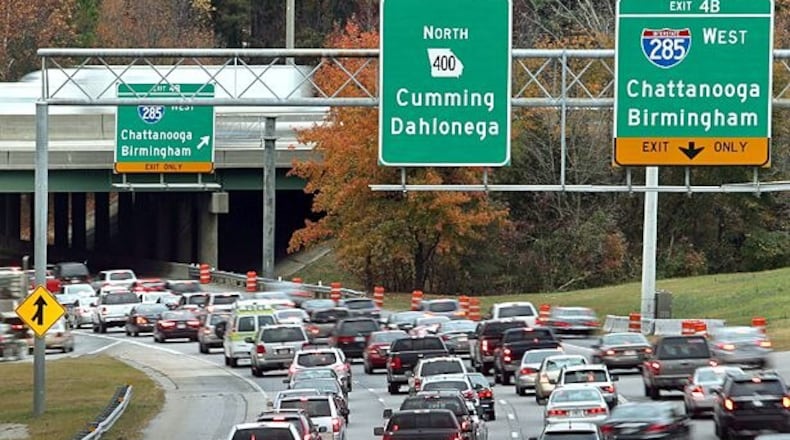Georgia transportation officials are moving forward with plans to add toll lanes to some of metro Atlanta’s busiest highways.
The Georgia Department of Transportation is analyzing proposals from two firms interested in building toll lanes along Ga. 400 in Fulton and Forsyth counties. The agency expects to recommend a contractor to the State Transportation Board in August.
Meanwhile, the board on Thursday agreed to a contracting approach for toll lanes along the top half of I-285 and along Ga. 400 to the North Springs MARTA station. GDOT has changed the timetable for those lanes several times, and it’s unclear when construction will begin.
Thursday’s actions were another step in GDOT’s plans for 120 miles of metro Atlanta toll lanes. The agency has already opened 67 miles of lanes along I-85 northeast of Atlanta, I-75 and I-575 to the northwest and I-75 south of the city.
But the biggest projects are yet to come.
GDOT plans to build toll lanes along 16 miles of Ga. 400. But its first attempt was sidetracked three years ago when the board rejected the lone responsive proposal, which far exceeded GDOT’s $1.7 billion budget for the project.
The agency has since tried again and is now analyzing two proposals it received last week, said Tim Matthews, GDOT’s express lanes administrator. The project includes two new toll lanes in each direction from the North Springs MARTA station to McGinnis Ferry Road, plus one new toll lane in each direction from McGinnis Ferry to just north of McFarland Parkway.
The agency also plans to build two lanes in each direction along 40 miles of the top half of the Perimeter. The estimated cost: more than $6 billion. The lanes have been split into two sections for contracting purposes.
One project includes lanes from I-20 east of Atlanta to Northside Drive and along Ga. 400 to the North Springs station. The second project includes lanes from Northside Drive to I-20 west of Atlanta.
The board approved plans to allow GDOT to use “comprehensive development agreements” for both projects. The agreements would allow the agency to negotiate multiple phases of construction with the chosen contractors. The negotiations would determine the specific segments, costs, timetables and designs of each phase of construction.
GDOT has pushed back the timeline for construction of the I-285 lanes several times in recent years and broken them into smaller segments to stretch taxpayer dollars and encourage more competition among contractors.
“They cannot be built as one contract, as much as we’d like,” Matthews told the board.
GDOT has opted to allow private companies to operate the lanes on I-285 and Ga. 400 — setting toll rates and collecting the revenue — in exchange for helping to pay for the massive projects. The agency says that approach will stretch taxpayer dollars further than if the public paid the full cost.
Critics fear private operators will have an incentive to charge higher tolls.
The public funding comes from a gas tax increase the General Assembly approved in 2015. The following year, then-Gov. Nathan Deal unveiled a 10-year highway construction program that includes the toll lanes.
Other projects include new I-285 interchanges at I-20 east and west of Atlanta, the widening of I-85 northeast of the city and new trucks-only lanes between Macon and McDonough on I-75.
About the Author
Keep Reading
The Latest
Featured





